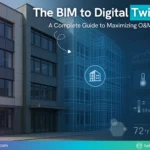The Implicit Case for BIM and building resilient infrastructure in the USA
September 17, 2021

On March 31, 2021, US President Joe Biden announced his ‘once-in-a-generation investment plan to revive the nation post the pandemic and create the most resilient economy in the world. He put forward a USD 2 trillion infrastructure plan designed to create employment, upgrade the infrastructure and tackle climate change.
President Biden’s vision is to create a robust infrastructure that is safe, environment-friendly, and can withstand climate change. He has allocated more than USD 600 billion to ramp up the existing infrastructure through this plan: including railways, bridges, ports, and highways. However, repairing existing infrastructure has its own set of challenges.
Traffic interruptions during construction and repair are one of the primary challenges in road and railway projects, and the management of ground utilities like sewage lines, telephone cables, water supply, etc is complex as well. People will still be commuting by roads, rail, and airports that are undergoing renovations or upgrades. While completing the project on time is a priority, construction planners and managers have to ensure that the daily commute isn’t interrupted. If these nuances are not considered during the planning stage, clashes may arise during implementation, which culminates in rework and project delays. In addition, weak contract management and lack of coordination between project stakeholders cause further delays and losses.
Radical infrastructure transformation calls for meticulous planning, designing, and timely project completion. The buck stops at every step, therefore making the deployment of the right digital solutions quintessential. The way we see it, Building Information Modeling (BIM) should be the first step towards infrastructure upgradation in the USA.
The Swedish transport administration, Trafikverket, which manages the design, construction, and maintenance of all state-owned roads and railways offers a good case study. Since 1994, Trafikverket has been implementing BIM in rail projects; Hallandsås tunnel project being one of them. Considering the on-ground challenges like high-water pressure, excavation through hard rock, soft rock, and clay, Trafikverket implemented BIM for streamlined planning and engineering and timely project delivery of the Hallandsås tunnel project.
During the tunneling, the real-time ground conditions were fed into the 3D model that helped stakeholders assess design errors and other risks in engineering. The shared model kept all stakeholders abreast with the project progress and ensured smooth coordination. With the help of BIM, project members could identify around 200 non-constructable conflicts and 3,000 unique collisions at the design stage, which led to a saving of around 4.5 million pounds on the project. (Source: The Informed Infrastructure magazine, May 2014 issue)
The utilization of BIM models can extend way beyond design, as it stores data at every construction phase and beyond. Parameters like quantities of raw materials, cost estimation, scheduling and monitoring construction progress, resources deployed, safety and sustainability statistics, etc can be computed.
BIM models can also be used in simulation studies to gauge the impact of natural disasters on any asset. BIM makes Assets better managed after disasters. Such information arms the project team in decision-making at the early design stage, and in taking corrective action, thereby, reducing the financial burden of repairs in the future. In high flood zone areas, using model-based flood analysis and simulation, project members can gauge potential flooding damage on infrastructure and modify the designs. For example, changing the elevation on the road can mitigate risks in a flood-prone area.
So far, we have only heard stories about the far-reaching effects of the pandemic on the US economy. The President’s vision will strengthen the country’s backbone and make the aging infrastructure future-ready. We are confident that BIM can offer a competitive edge to planners, construction firms, architects, and all others who will carry the torch of the President’s vision.
BIM can certainly be the fulcrum for building a robust, resource-efficient, and sustainable infrastructure in USA!















